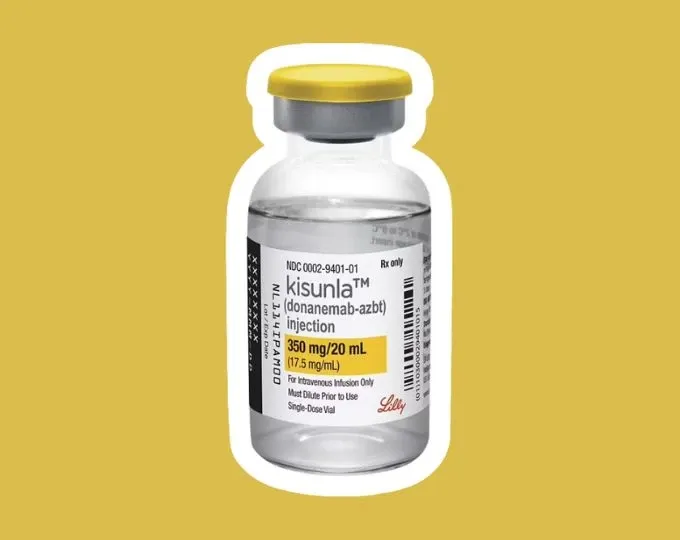Kisunla (Donanemab-azbt) Drug Info
Comprehensive guide on Donanemab (Kisunla) administration, dosing, safety monitoring, and efficacy data for early-stage Alzheimer's disease

Donanemab-azbt (Kisunla) represents a significant advancement in Alzheimer disease (AD) treatment, particularly for early-stage patients. Below are key clinical pearls for healthcare professionals:
Indications & Patient Selection
- Approved for early symptomatic Alzheimer disease, including mild cognitive impairment and mild dementia stages with confirmed amyloid pathology via PET or CSF biomarkers.
- Most effective in patients with low-to-medium tau pathology (35% disease progression slowing vs. 22% in mixed tau populations).
Dosing Protocol
- Initial phase: 700 mg IV every 4 weeks × 3 doses
- Maintenance: 1400 mg IV every 4 weeks thereafter
- Stopping criteria: Therapy can be discontinued once amyloid plaques are reduced to minimal levels on PET imaging (achieved in 17-69% of patients by 76 weeks).
Administration Essentials
- Requires 30-minute IV infusion with 0.9% NaCl dilution to 4-10 mg/mL.
- Pre-infusion checks:
- Baseline brain MRI
- APOE ε4 genotyping (higher ARIA risk in homozygotes)
- Amyloid confirmation
- Infusion reactions: Monitor for fever, chills, hypotension, or dyspnea. Pre-medication with antihistamines/steroids may be considered.
Safety Monitoring
- ARIA (Amyloid-Related Imaging Abnormalities):
- MRI required before 2nd, 3rd, 4th, and 7th infusions
- 24% incidence of ARIA-Edema (ARIA-E) in trials
- Suspend dosing for symptomatic ARIA; permanent discontinuation for severe cases
- Other risks: Microhemorrhages (19.1%), superficial siderosis (15.5%)
Efficacy Evidence
- TRAILBLAZER-ALZ 2 trial (N=1,736):
- 35.1% slower decline on iADRS vs placebo (low/medium tau group)
- 39% reduced risk of progressing to next disease stage
- Amyloid plaque reduction: 61% at 6 months, 84% at 18 months
Patient Education Points
- Emphasize disease modification rather than cure
- Discuss infusion commitment: Monthly visits for ≥6 months
- Review ARIA symptoms: Headache, confusion, visual changes
- Highlight stopping potential: Reduced treatment burden if plaques clear
Practice Considerations
- Use shared decision-making tools to weigh benefits vs risks (ARIA, cost, infusion logistics)
- Coordinate with radiologists for standardized MRI monitoring
- Consider amyloid PET availability and insurance coverage barriers
This monoclonal antibody offers a unique stop-and-monitor treatment paradigm, but requires careful patient selection and multidisciplinary management to optimize safety outcomes.
[2] https://www.drugs.com/monograph/donanemab-azbt.html
[3] https://www.neurologylive.com/view/guidance-safe-use-donanemab-ad-clinical-settings-gil-rabinovici
[4] https://www.veteranshealthlibrary.va.gov/medicationsva/203,a624048
[5] https://www.saintlukeskc.org/health-library/donanemab-azbt-injection
[6] https://www.pharmacytimes.com/view/kisunla-from-eli-lilly
[7] https://www.medcentral.com/drugs/monograph/189031-324037/donanemab-azbt-intravenous
[8] https://medlineplus.gov/druginfo/meds/a624048.html
[10] https://medicalpolicy.bcbstx.com/content/dam/bcbs/medicalpolicy/pdf/rx/RX501.177_2025-03-15.pdf
[11] https://hhs.iowa.gov/media/14833/download?inline
[12] https://www.webmd.com/drugs/2/drug-189031/donanemab-azbt-intravenous/details
[14] https://alzheimersnewstoday.com/ly3002813/
[15] https://www.mdpi.com/2226-4787/13/1/23
[16] https://www.aetna.com/cpb/medical/data/1000_1099/1066.html
[17] http://mcgs.bcbsfl.com/MCG?mcgId=09-J4000-94&pv=false
[18] https://everyone.org/blog/donanemab-approval
[22] https://www.uhcprovider.com/content/dam/provider/docs/public/policies/comm-medical-drug/kisunla.pdf
